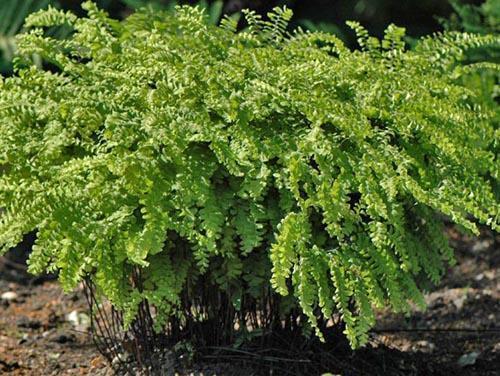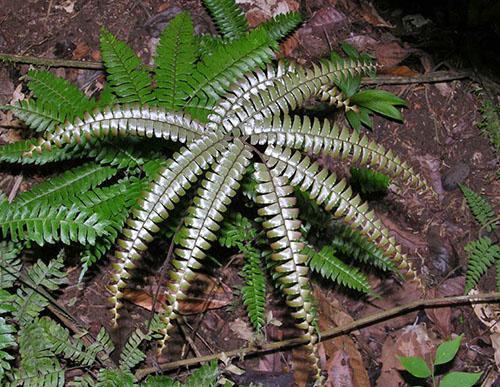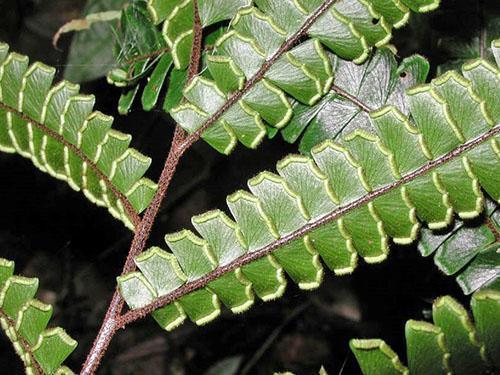Choosing a maidenhair for the house according to the photo and description of the species
 In addition to the well-known to many lovers of indoor plants maidenhair Venus hair, many related species are interesting, unpretentious and decorative. To better represent all the variety of ferns, it is useful to study the descriptions of the maidenhair species and photos of these beautiful and very unpretentious plants.
In addition to the well-known to many lovers of indoor plants maidenhair Venus hair, many related species are interesting, unpretentious and decorative. To better represent all the variety of ferns, it is useful to study the descriptions of the maidenhair species and photos of these beautiful and very unpretentious plants.
Four-leafed maidenhair (A. Tetraphyllum)

The leaf stalks are painted in green-brown tones and rise almost half a meter above the ground. The leaves are somewhat drooping, with lobes alternately collected on the rods. The lobes themselves are asymmetric trapezoidal, medium-sized, glossy on the outside. Densely set sori are located along the edge on the back side.
 Four-leafed maidenhair perfectly tolerates life in indoor conditions. Propagated by dividing the rhizome, which is thick in the fern and extending shallowly under the surface of the substrate.
Four-leafed maidenhair perfectly tolerates life in indoor conditions. Propagated by dividing the rhizome, which is thick in the fern and extending shallowly under the surface of the substrate.
Transparent maidenhair (A. diaphanum)
 For this maidenhair, as in the photo, the formation of double-pinnate leaves, excised along one edge, is characteristic. Segments of a leaf do not exceed three centimeters in length, while the total length of a narrow, pointed leaf can be up to 25 centimeters.
For this maidenhair, as in the photo, the formation of double-pinnate leaves, excised along one edge, is characteristic. Segments of a leaf do not exceed three centimeters in length, while the total length of a narrow, pointed leaf can be up to 25 centimeters.
The lobes are wide, obovate or oval, green. The petioles are dark, with a green or brown tint. Convex sporangia are located along the outer edge of the leaf.
The total height of the decorative type reaches 35-40 cm, while the fern, native to Indochina, Australia or Polynesia, grows well in the apartment.
Tailed maidenhair (A. caudatum)
 The homeland of this type of maidenhair, which prefers to settle not only on stones, but also on the trunks of large representatives of the flora, is South America. The tailed maidenhair is distinguished by the presence of long, up to 40 cm leaves.
The homeland of this type of maidenhair, which prefers to settle not only on stones, but also on the trunks of large representatives of the flora, is South America. The tailed maidenhair is distinguished by the presence of long, up to 40 cm leaves.
Leaves of the first order on the petioles are arranged alternately, tightly to each other. They have a trapezoidal, strongly dissected shape. The teeth are blunt or rounded along the edge. Spores are located on the outer side of leaf segments, in dense sporangia notches formed along the cut.
 As a room culture, the tailed maidenhair is more capricious than other types of maidenhair. The plant requires more frequent glaze, since dry soil for fern rhizomes is destructive. It is just as important to maintain high humidity in the room where the maidenhair species shown in the photo is contained.
As a room culture, the tailed maidenhair is more capricious than other types of maidenhair. The plant requires more frequent glaze, since dry soil for fern rhizomes is destructive. It is just as important to maintain high humidity in the room where the maidenhair species shown in the photo is contained.
Wedge-shaped maidenhair (A. cuneatum)
 The fern is native to the South American rainforests in appearance and structure of the crown and leaves resembles other varieties of maidenhair, already loved by flower growers. The fundamental difference between the wedge-shaped maidenhair is in the shape and arrangement of the sori. In this case, the spores mature in the grooves along the edge of the first-order leaves. The sporangium is shaped like a kidney or a horseshoe.
The fern is native to the South American rainforests in appearance and structure of the crown and leaves resembles other varieties of maidenhair, already loved by flower growers. The fundamental difference between the wedge-shaped maidenhair is in the shape and arrangement of the sori. In this case, the spores mature in the grooves along the edge of the first-order leaves. The sporangium is shaped like a kidney or a horseshoe.
Adiantum finely pubescent or fine-haired (A. hispidulum)
 In nature, the small-haired maidenhair is found in the mountainous regions of Africa, where the plant can also be seen in the foothills, overgrown with dense forests, almost on the line of snow.Representatives of this type of maidenhair can be found in other parts of the world, for example, in Australia, New Zealand and India.
In nature, the small-haired maidenhair is found in the mountainous regions of Africa, where the plant can also be seen in the foothills, overgrown with dense forests, almost on the line of snow.Representatives of this type of maidenhair can be found in other parts of the world, for example, in Australia, New Zealand and India.
The adiantum hispidylum forms palm-shaped dissected leaves with diamond-shaped segments. The length of such a sheet can reach 45 cm.
 The sporangia of the small pubescent maidenhair are located along the cut line of the leaf segment almost closely to each other. The petioles, like in many varieties of maidenhair, are dark, thin, rather strong.
The sporangia of the small pubescent maidenhair are located along the cut line of the leaf segment almost closely to each other. The petioles, like in many varieties of maidenhair, are dark, thin, rather strong.
The view is of interest both for lovers of home floriculture and those who are fond of growing ferns in the winter garden.
Trapezoidal maidenhair (A. trapeziforme)
 A fairly large perennial plant, even in indoor conditions grows up to a meter in height. The birthplace of the trapezoidal maidenhair is Central and South Africa, where the fern prefers to settle in the shade of large plants.
A fairly large perennial plant, even in indoor conditions grows up to a meter in height. The birthplace of the trapezoidal maidenhair is Central and South Africa, where the fern prefers to settle in the shade of large plants.
The culture tolerates daily and seasonal temperature changes well, but reacts negatively to dry air and drying out of the soil. The leaf petioles are almost black, thin. Large leaves, spreading under natural conditions, in a pot form a beautiful drooping crown.
Segments of the leaf of this maidenhair, as in the photo, are diamond-shaped, light green, with a rounded-toothed, asymmetrical edge. Areas of spore formation and maturation are concentrated along the leaf lobe cut.
Beautiful maidenhair (A. venustum)
 This neat and very elegant plant is barely 20 centimeters tall. The homeland of the beautiful maidenhair is the subtropical regions of Indochina, where the species, as in the photo, settles on stone placers under the forest canopy.
This neat and very elegant plant is barely 20 centimeters tall. The homeland of the beautiful maidenhair is the subtropical regions of Indochina, where the species, as in the photo, settles on stone placers under the forest canopy.
According to the photo and description of the maidenhair, it has complex-pinnate openwork leaves with segments of an ovoid-shaped form. The outer edge, where spores mature, is finely toothed. The color of the leaves is light green.
Beautiful maidenhair (A. formosum)
 The beautiful maidenhair, which lives in the Australian and New Zealand forests, is characterized by repeatedly dissected openwork leaves about 60 cm long. The green segments are small, diamond-shaped, often asymmetrical, with a thin leaf blade.
The beautiful maidenhair, which lives in the Australian and New Zealand forests, is characterized by repeatedly dissected openwork leaves about 60 cm long. The green segments are small, diamond-shaped, often asymmetrical, with a thin leaf blade.
 Dark, medium-sized sporangia are located on the outer cut of the leaf. The petioles of the maidenhair, as seen in the photo, are brown, and in the lower part they are almost black. The plant is suitable for home cultivation, perfectly tolerating maintenance in shade or partial shade.
Dark, medium-sized sporangia are located on the outer cut of the leaf. The petioles of the maidenhair, as seen in the photo, are brown, and in the lower part they are almost black. The plant is suitable for home cultivation, perfectly tolerating maintenance in shade or partial shade.
Tender maidenhair (A. tenerum)
 You can see the gentle maidenhair in natural conditions in the tropical zone of the American continent, as well as in the Antilles. According to the description and photo of the maidenhair, it can be understood that the plant is of great interest to flower growers. At the same time, do not forget that the species is quite large. Its leaves sometimes reach a length of 0.7 meters. They have a threefold feathery shape. Small, broadly wedge-shaped segments densely set on thin, rigid petioles almost 30 cm long.
You can see the gentle maidenhair in natural conditions in the tropical zone of the American continent, as well as in the Antilles. According to the description and photo of the maidenhair, it can be understood that the plant is of great interest to flower growers. At the same time, do not forget that the species is quite large. Its leaves sometimes reach a length of 0.7 meters. They have a threefold feathery shape. Small, broadly wedge-shaped segments densely set on thin, rigid petioles almost 30 cm long.
 At home, the plant requires the same care and maintenance as the better-known maidenhair Venus hair. The fern adapts well to growing in a pot, reproduces well in vegetative ways. The plant can be used for cutting.
At home, the plant requires the same care and maintenance as the better-known maidenhair Venus hair. The fern adapts well to growing in a pot, reproduces well in vegetative ways. The plant can be used for cutting.
 Delicate maidenhair Farleyense is a graceful plant native to Barbados. Small light leaves of the first order are densely excised along the edge, which gives them a fringed appearance. Young foliage has a noticeable golden or pink hue. Mature leaves reach a height of 25-30 centimeters.
Delicate maidenhair Farleyense is a graceful plant native to Barbados. Small light leaves of the first order are densely excised along the edge, which gives them a fringed appearance. Young foliage has a noticeable golden or pink hue. Mature leaves reach a height of 25-30 centimeters.
In home content, the maidenhair, as in the photo, is more capricious than similar varieties. This is reflected in the fear of drafts, demanding air humidity and mandatory protection from the sun.